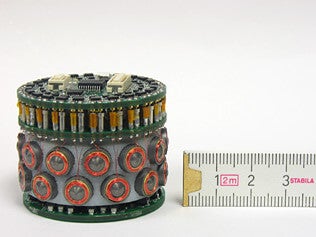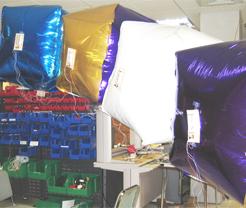We still tell our children “you can be anything when you grow up.” It’s time to start telling them “you’re going to be able to make anything…right now.” Similar work at MIT and Carnegie Mellon is pointing towards the next revolution in computers and manufacturing: programmable matter. In the future you won’t use computers to design a car, the car will form from billions of tiny computers that arrange themselves into anything you want. The physical and computational world will merge. Hope you’re ready.

How can a material be intelligent? By being made up of particle-sized machines. At Carnegie Mellon, with support from Intel, the project is called Claytronics. The idea is simple: make basic computers housed in tiny spheres that can connect to each other and rearrange themselves. It’s the same concept as we saw with Modular Robotics, only on a smaller scale. Each particle, called a Claytronics atom or Catom, is less than a millimeter in diameter. With billions you could make almost any object you wanted. See the concept video after the break.
Carnegie Mellon isn’t the only university pursuing intelligent materials. MIT’s Center for Bits and Atoms (CBA) is actively trying to merge physics and computer science. Neil Gershenfeld, CBA’s director and one of the leaders in computational physics, is seeking to design, build and program computers that are what they compute. He’s taking the “bit” and turning it into an “it,” instead of the other way around.
It All Looks Good on Paper
It would be amazing if these technologies were available today, but they are still a long way off. In fact, as far as accomplishments, modular robotics on the human sized scale have shown a lot more success. What makes CBA and Claytronics so interesting is that they are proceeding at a steady (albeit slow) pace and making clear progress in the underlying research of the concept.
In hardware, Claytronics has already made centimeter sized cylindrical catoms that have basic features. They can latch together and recognize when they are latched, and they can be moved using electrostatic forces. Carnegie Mellon is also researching how to power the catoms using magnetic resonance coupling (having each catom convert a magnetic field into electricity). Catoms will be so small that electric forces will be more important than gravity so they’re using helium filled cubes to test how catoms will work when gravity is no longer the dominate force.

Software research is just as rigorous. Programmers have to create a system where catoms can communicate wirelessly over relatively long ranges and with little power. In a single cubic meter, there could be a billion catoms. That means a billion computers trying to talk to each other and move themselves to form a shape. It’s a daunting task but it’s helped by a great concept known as “fungibility.”
When something is fungible, not only is twice as many twice as useful, half as many is half as useful. Bread is fungible, a human is not. Cut one in half and you still have food, cut the other in half and you go to jail. Right now, computers are not fungible. With programmable matter, they would be. That same cubic meter of a billion catoms is essentially a network of a billion computers. That’s a lot of computational power – more than enough to organize it into different shapes. And if the computer was separated into sections, the overall computing power would still be the same. Don’t try that with your laptop.
Fungbility is a concept that Gershenfeld at CBA can really get behind. At TED 2006, he discussed how programmable matter and fungible computers will allow you to “pour out” as much computer as you need to solve a problem. The amount of computational strength you need would be matched by a physical quantity in the real world. Watch his talk below, but be warned: it’s long, he talks fast, and some of the ideas are a little heady.
What will it mean for us to be Post-Scarcity?
For those of you who managed through all seventeen minutes of Gershenfeld’s talk, you’ll notice a lot of it didn’t have anything to do with programmable matter at all. He started discussing “fabrication labs” as well. The two concepts are related. When you have programmable matter, tiny computers will be able to form into any shape. You’ll be able to make almost anything. So what will we do with this technology?
Working with non-programmable matter, Gershenfeld organized a lab with some basic tools: a laser cutter, milling machines, a sign cutter, and programming instruments. Costing somewhere around $20,000 these basic labs can make almost any useful modern device. Computer boards, antennas, you name it. He shared these labs with educational groups all over the world. What did he find? Human ingenuity is more powerful than previously expected.
Children, and adults, were designing chips, tools, and many other inventions to solve local problems. By providing the means, local solutions arose from local inventors. This, my friends, is one of the most promising aspects of programmable matter: when we can build anything, we can solve any problem. The programmable matter will provide the computational power and the physical forms that we can organize into tools to fix…well…everything.
That’s the dream, and I believe in it, but I would be amiss if I didn’t point out the nightmare. Look at the weapons humanity has made from sticks and stones and you can begin to imagine the destruction that could be unleashed with programmable matter. Even if we learn to love and let live, the programmable matter will have a huge amount of computational power, enough to support artificial intelligence. Can we hope to control a material that can out-think and out-build us?
Fear doesn’t help us much, however. Intelligent material isn’t just a powerful and promising concept, it’s an inevitable invention. Computer chip manufacturers are creating smaller and smaller devices, modular robotics are becoming more sophisticated, and artificial intelligence is pre-natal but growing. These trends will converge and lead us to programmable matter eventually. Instead of fearing that development, we can work to understand it better and harness it for limitless possibilities.
Because that’s a real likelihood. The world could really use programmable matter to move beyond living for day to day necessities and start exploring humanity’s potential. When everyone has access to a fabrication lab that can make almost anything, the world will be populated by inventors. Not only will every cubic meter have billions of computers, the world will have 7 billion (or more) human minds guiding those computers to new discoveries. In our life times, or our children’s, we will come to realize an inevitable and quite literal truth: the world is what we make it.


